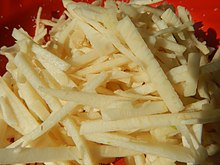
Back جمار Arabic Cor de palmera Catalan Palmherz German Palmomedolo Esperanto Palmito (gastronomía) Spanish پنیر نخل Persian Cœur de palmier French Palmito Galician Cabbash phalm GV לבבות דקל HE


Heart of palm is a vegetable harvested from the inner core and growing bud of certain palm trees, most notably the coconut (Cocos nucifera), juçara (Euterpe edulis), açaí palm (Euterpe oleracea), palmetto (Sabal spp.), and peach palm. Harvesting of many uncultivated or wild single-stemmed palms (e.g. Geonoma edulis) results in palm tree death.[1] However, other palm species are clonal or multi-stemmed plants (e.g. Prestoea acuminata, Euterpe oleracea), and moderate harvesting will not kill the entire clonal palm. Heart of palm may be eaten on its own, and often it is eaten in a salad.
There are palm varieties that have become domesticated farm species as an alternative to sourcing from wild palms. The main variety that has been domesticated is Bactris gasipaes, known in English as peach palm.[2] This variety is the most widely used for canning. Peach palms are self-suckering and produce multiple stems,[3] with up to 40 on one plant. This lets producers lower costs by harvesting several stems from a plant while avoiding the death of the palm. Another advantage is that the peach palm has been selectively bred to eliminate the thorns of its wild cousins. Since harvesting is still labor-intensive, palm hearts are regarded as a delicacy.
- ^ Sylvester, O.; Avalos, G. (2009). Illegal palm heart (Geonoma edulis) harvest in Costa Rican national parks: patterns of consumption and extraction. Economic Botany. 63(2): 179-189.
- ^ Zeldes, Leah A. (2010-11-17). "Eat this! Heart of palm, an exotic taste of the tropics". Dining Chicago. Chicago's Restaurant & Entertainment Guide, Inc. Archived from the original on 2018-07-18. Retrieved 2011-05-18.
- ^ Rose Kahele (August–September 2007). "Big Island Hearts". Hana Hou! Vol. 10, No. 4.